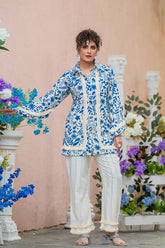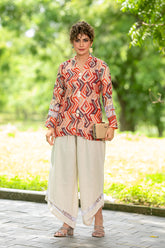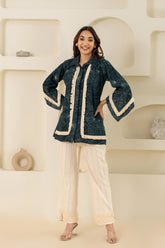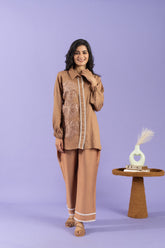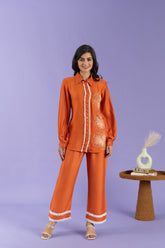Warm vs. Cool Tones: How to Master the Art of Color Mixing in Women's Apparel

Color is a powerful tool in fashion, and knowing how to use it well can elevate your style instantly. One of the key principles in color styling is understanding warm and cool tones. These two broad categories can transform an outfit—either making it sing or fall flat.
By learning the difference between warm and cool tones and how to mix them, women can build more cohesive, flattering, and stylish outfits. With the rise of bold and expressive dressing in today’s fashion scene, mastering this art isn’t just useful—it’s essential. At ZNKL, we champion this approach by creating fashion-forward pieces that make color mixing effortless and empowering.
2. What Are Warm and Cool Tones?

Warm Tones
Warm tones include red, orange, yellow, and any hues that have golden, peachy, or earthy undertones. Think of the colors of a sunset or autumn leaves. These shades feel energetic, passionate, and full of life. In fashion, they bring vibrancy and a sense of warmth to the outfit.
Cool Tones
Cool tones lean toward blue, green, and purple, or any colors with icy, bluish, or minty undertones. Picture ocean waves or a crisp winter morning. These shades give a calming, composed, and fresh look to any ensemble.
Visual Shortcut:
-
Warm = Fire, sunlight, spices
-
Cool = Water, sky, shadows
Having this mental palette helps you instantly categorize and understand how different colors work together—or clash.
3. Why Mixing Warm and Cool Tones Works

When done right, mixing warm and cool tones creates an outfit that’s rich, balanced, and visually interesting. The contrast between the tones generates depth, helping each color pop without overwhelming the whole look.
This kind of color play also adds a layer of personality. A woman who wears a fiery red skirt with a cool lavender blouse signals confidence and creativity. These combinations can mirror moods too—calm yet bold, collected yet adventurous.
Instead of choosing one color story, you can wear both sides—and own it.
4. Tips for Mixing Warm and Cool Tones

Use Neutrals as Buffers
Neutrals like black, white, beige, gray, or denim help mediate between opposing tones. They soften the contrast and create flow, making your outfit feel intentional rather than chaotic.
Choose One Dominant Tone
Pick a lead player. If you’re going for a warm-toned outfit, sprinkle in cool accents (and vice versa). This helps the eye know where to focus and avoids the look from becoming too scattered.
Be Mindful of Proportions
Think about where each tone lives in your outfit. Try a warm-toned blazer with a cool-toned bag. Or a cool maxi skirt with a warm-toned crop top. Balance is everything.
Consider the Season
Seasonal palettes can guide your choices:
-
Fall/Winter: Rich burgundy, mustard, terracotta, deep olive
-
Spring/Summer: Aqua, mint, coral, lemon yellow
Use the season’s natural colors to inspire your combinations while still blending tones creatively.
5. Example Outfit Ideas
Look 1: Red Blazer Over a Cool Blue Blouse
A strong red blazer adds power and warmth, while a soft blue blouse keeps the outfit grounded and calm. Add cream trousers for neutrality and you’ve got a professional yet striking look.
Look 2: Green Skirt with a Warm Orange Top
A moss green or emerald skirt brings the cool, earthy vibe. Add a warm orange top—something tangerine or burnt sienna—for a fresh, fashion-forward statement. Pair with nude heels or white sneakers.
Look 3: Neutral Outerwear with Warm and Cool Accents
Start with a beige trench or black coat. Add a warm rust-colored scarf and a cool-toned mint crossbody bag. This outfit plays with tone subtly and stylishly, proving accessories are powerful tools for mixing.
6. Common Mistakes to Avoid When Mixing Warm and Cool Tones

Overloading with One Tone
Too much of one temperature can make your outfit feel flat or overdone. Always aim for at least one contrasting piece, even if it’s just a small accessory.
Clashing Colors
Not all warm and cool tones get along. Pairing a neon green with cherry red can read more Christmas-themed than chic. Stick to shades with similar saturation levels for harmony.
Not Considering Skin Tone
Skin undertones can affect how colors look on you.
-
If you have warm undertones, warm shades will make you glow; cool tones may wash you out unless used sparingly.
-
If you have cool undertones, icy and blue-based colors will flatter you more.
Use the “vein test” or jewelry preference (gold vs. silver) to figure out your undertone and plan color pairings accordingly.
7. Conclusion
Understanding warm and cool tones isn’t just fashion theory—it’s a practical way to upgrade your wardrobe. When you know how to mix these tones smartly, you unlock endless outfit possibilities that are bold, beautiful, and totally you.
Start experimenting with your own combinations. Try a warm scarf with a cool-toned dress or mix your accessories to balance out a strong color. Most importantly, have fun with it—because personal style should feel like freedom, not a formula.
Got a favorite warm and cool combo? Drop it in the comments—we want to see how you wear it.
Frequently Asked Questions
A: Cool-toned clothes have blue, green, or purple undertones and give off a crisp vibe. Warm-toned clothes include reds, oranges, and yellows, adding warmth and energy to your outfit.
A: Warm tones include reds, oranges, and yellows, often associated with sunlight. Cool tones like blue, green, and purple feel calming and fresh, like water and sky.
A: If you have warm undertones, warm colors will suit you best. If your undertones are cool, then cooler colors will be more flattering on you.
A: Check the undertones. Warm clothes show hints of red, orange, or gold, while cool ones lean toward blue, green, or silver.
A: Look at the veins on your wrist—green means warm undertones; blue or purple means cool. Jewelry test and paper test also help.
A: Yes, but warmer shades like chocolate brown or olive may suit you better. If wearing black, balance it with warm makeup or accessories.
A: Use the vein test or white paper test. Green veins = warm undertone; blue/purple veins = cool undertone.
A: Warm colors remind you of the sun—reds, oranges, yellows. Cool colors feel like water and sky—blues, greens, purples.

